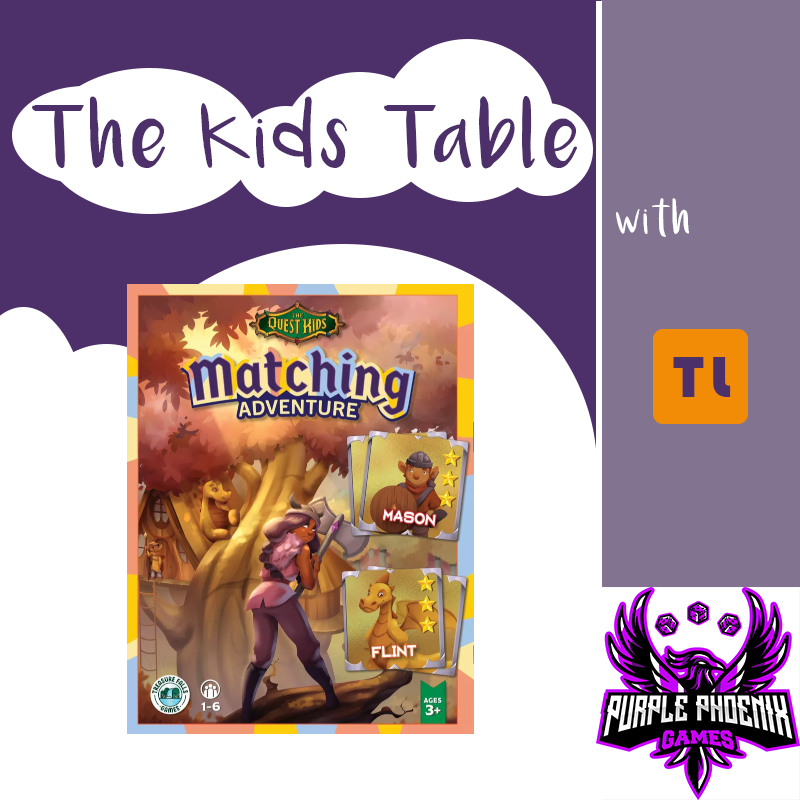
Those of you with kids: you know how you are just aching for a good game to come out that will satisfy your 3-year-old’s interest, keep their attention throughout, and even get them talking about board games afterward? At least a game that isn’t super-basic and boring? Well have I a treat for you today. I may have just found the game for us!
| The Quest Kids: Matching Adventure (2021) | Treasure Falls Games |
| 1-6 Players | 20 minutes |
| Ages 3+ | BGG Weight – (not yet available) |
The Quest Kids: Matching Adventure (can I please just call it MA from here please?) is a tile matching game based off the old evergreen Memory mechanic. However, this isn’t your gramma’s Memory. In it players are recruiting The Quest Kids to scare off the silly bad guys by matching tiles and collecting treasures. The player with the most stars at the end of the game will be the winner! But in actuality, all the players will be winners because all will have had a great time.
DISCLAIMER: We were provided a copy of this game for the purposes of this review. This is a retail copy of the game, so what you see in these photos is exactly what would be received in your box. I do not intend to cover every single rule included in the rulebook, but will describe the overall game flow and major rule set so that our readers may get a sense of how the game plays. For more in depth rules, you may purchase a copy online or from your FLGS. -T
To setup, shuffle the brown tiles, forest tiles, and river tiles separately. Lay out the brown treehouse tiles face-down into a 5 x 4 grid. Around these brown tiles will be placed the river tiles and forest tiles, the numbers of which are dependent upon how lengthy the players wish the game to be. Add the appropriate types of treasure tokens to the provided treasure chest and the game is ready to begin! We ALWAYS let our little go first. They like that.

On a turn each player will attempt to recruit a Quest Kid Hero from the brown treehouse tiles. Once a match has been found the player may begin taking their hero on an adventure! Adventures can only be attempted when a player has matched two Hero tiles from the treehouse. An adventure consists of finding a matching pair of bad guys, one each from the forest and river. For example, in order to find the matching Honey Beard bad guy tiles a Hero would need to search the river for one tile AND the forest for its match.
When bad guys are matched they provide the player with a certain number of treasures, as printed on their tile. The player reaches into the treasure chest and pulls out the correct number of treasures (my son’s favorite part). These treasures provide a number of stars (VP) depending on whether the player has matched a specific hero or not. Less stars are awarded if the appropriate hero is absent, more stars if that hero has been matched by the player.
Some treehouse tiles contain Quest Kid Allies. These Allies provide stars, but also very helpful special abilities to be used on a future turn. When these Allies are matched, the active player keeps the tile with stars and gives away the matching tile to another player. So that other player may also use the Ally for its special ability on a future turn. Alliances with a 3-year-old? I can dig it! Alliances that do not involve said 3-year-old? Watch out for the forthcoming tantrum.
Play continues in this fashion of matching tiles, scaring away bad guys and receiving treasures, and utilizing Ally special abilities until all tiles have been matched and claimed. Players all add up their stars on their collected tiles and treasures, and the most stars collected wins the game!

Components. This game is a ton of tiles and treasure tokens. That equates to, well, a whole bunch of thick cardboard in a box. The material quality is very good, but I am most impressed with the art style. I love game art that can be cartoony while also being interesting and detailed. Such is the art here. The characters are really well illustrated and each have their own personality. I have one gripe about the components: the treasure tokens feature a small picture of the Hero that allows it to be worth more stars. That Hero picture is very very tiny and details do not really transfer well to the small space, so it IS difficult to know which Kid will power up the treasure. I did find a workaround if players are not colorblind: each Hero is featured along with a color. That same color is used as the token icon and can more easily be matched to the Hero. It may save some headache if players are able to use the color as the indicator instead of the tiny picture.
In a nutshell this is Memory with strategy. The main game mechanic is memory – matching up the tiles in order to collect them. However, by throwing in the randomness of treasure token pulls and the Ally special abilities, MA just becomes a thousand percent more compelling for children and adults alike. At the end of the game my son is having a great time and almost always asks to play again. The adults are also impressed that Memory can be so much fun!
So if you are looking for that game to introduce to your youngster that actually challenges their little minds, then I strongly recommend The Quest Kids: Matching Adventure. Yes, it’s Memory, but it’s Memory that is actually fun. It’s Memory with a theme, and a kid-based theme at that. It gives the littles an opportunity to look up to these kid heroes and lets them imagine being heroes themselves. Any game that helps to empower my children will definitely be a well-loved addition to my collection. Purple Phoenix Games (well, my wife, my son, and I) give this one a victoriously heroic 16 / 18. I won’t say that I will beat you every time, but my son may. I dare you to play against him. Just make sure you throw all your extra Allies to him or he will get real mad real quick.

